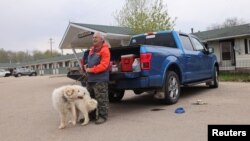The threat from a wildfire near Canada's oil hub of Fort McMurray, Alberta, appeared to be easing Wednesday, a day after it forced thousands of residents to evacuate and stirred memories of a damaging blaze nearly a decade earlier.
Favorable winds were expected to push the fire away from the city of about 68,000 in northwest Canada, where many residents work in the nearby oil industry.
The Fort McMurray fire comes as Canada is entering a new fire season. Last year's record number of wildfires sent choking smoke across parts of the U.S. and forced more than 235,000 Canadians to evacuate their communities.
But scientists have said it's not clear that wildfire smoke will present the same kind of problem it did last year, when unusual weather patterns drove the haze southward.
In Fort McMurray, about 6,600 residents fled parts of the city's southern end while others were on alert. It was familiar terrain for the Albertan city, which survived a catastrophic blaze in 2016 that destroyed 2,400 homes and forced more than 80,000 people to flee.
Jay Telegdi, who lost his home to that wildfire, watched from his balcony Tuesday as the sky over downtown turned orange and black. It "burned your eyes" to walk outside, Telegdi said in a phone interview, adding that it was slightly easier to breathe Wednesday.
"You can grow accustomed to it," said Telegdi, who works for the Athabasca Chipewyan First Nation. "We've come to accept columns of smoke blocking out the whole sky and yet we're still drilling for oil."
Canada is the world's fourth-largest producer of oil and fifth-largest producer of gas, a reality that sits uncomfortably with the nation's pledges to protect biodiversity and lead the global fight against climate change. When burned, oil and gas release heat-trapping carbon dioxide into the atmosphere, intensifying the very conditions that help wildfires scorch millions of acres.
In Canada last year, wildfires burned an area larger than New York state, releasing nearly three times the emissions produced by the country's entire economy in a year and sending hazardous air to U.S. cities thousands of miles away. No civilians died, but at least four firefighters died.
Dave Phillips, senior climatologist at Environment Canada, a government agency, said the smoke that reached the U.S. East Coast last year largely came from Eastern Canada.
"That was odd in the sense most wildfires in Canada are in British Columbia and Alberta. You rarely see a fire in Quebec and the smoke travels to the United States," Phillips said, adding that eastern Canada has seen a lot more rain this spring and has been much cooler.
Mike Flannigan, a professor of wildland fire at Thompson Rivers University in British Columbia, said "legacy effects" of last year's season are spilling over to 2024. Ongoing drought in western Canada, higher temperatures because of El Nino and so-called "zombie fires" that burn underground through the winter in organic matter and reappear once the snow melts in the spring are factors driving wildfires in some parts of the country.
In the neighboring province of British Columbia, a low-pressure system moving into the northern part of the province was expected to dampen activity at a blaze that has forced several thousand people to flee their homes in and around Fort Nelson, a town of about 4,700, the province's wildfire service said.
In Manitoba, about 500 people have been forced out of their homes in the remote northwestern community of Cranberry Portage ahead of a fire measuring more than 300 square kilometers. Officials said Wednesday that the fire was about 80% contained and residents might be allowed to return to their homes this weekend.










